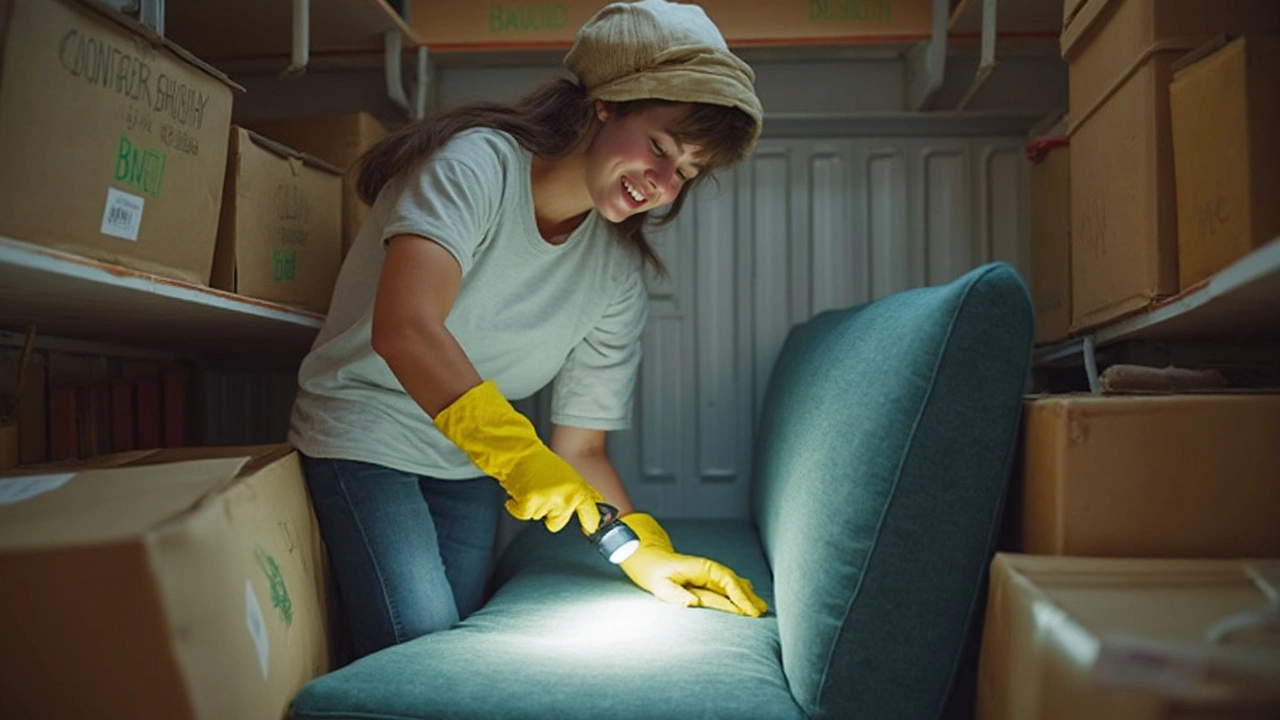Do Couches Get Moldy in Storage? What You Need to Know

Your couch isn’t just a big, squishy seat. It’s also a sponge for moisture—and that’s the real problem when stashing it away. Mold on stored couches happens a lot more than you’d think, whether you’re keeping something for a move or just clearing out some room for a bit.
What’s really going on here? Mold doesn’t care how expensive or new your sofa is. All it takes is a little trapped humidity in the storage unit or basement, and you can end up with a musty mess. Mold spores float around just waiting for a cozy, damp spot. Couches, especially those with fabric or foam, are pretty much the VIP lounge for mold if things get humid and stagnant.
Thing is, I learned this the hard way after my son Quincy helped me lug our old couch to a friend’s garage for a few months. If you don’t know how to tackle moisture and airflow, your couch can get ruined faster than you think. Let’s break down what you need to know—so your furniture comes out looking (and smelling) as good as when it went in.
- Why Do Couches Get Moldy in Storage?
- What Increases the Risk for Mold?
- Spotting a Mold Problem Early
- Best Ways to Prevent Mold on Couches
- How to Store Your Couch Safely
- What to Do If You Find Mold
Why Do Couches Get Moldy in Storage?
It’s all about moisture and airflow. Couches, especially those stuffed with foam or covered in thick fabric, hold onto humidity like champs. When you stick a couch in a storage unit, basement, or even a garage with poor ventilation, you’re basically handing mold a free buffet.
Mold spores are everywhere, just waiting for the right environment to grow. Here’s the deal—the second the air gets damp and doesn’t move much, those tiny spores settle in and start spreading on any soft surface. And a couch is full of places for them to hide: underneath cushions, deep in creases, inside armrests—anywhere air can’t easily get.
Really, all mold needs to thrive is:
- Humidity above 60% (super common in storage units and basements)
- Little to no airflow
- Organic material (fabric, wood, or even pet hair trapped in the couch)
If you stored your sofa after a spill or a steamy cleaning session, that trapped moisture can set off mold in just a few days. Even climate-controlled storage spaces aren’t always a guarantee—if someone opens the door on a rainy day, your couch could soak up that damp air and kick off the cycle.
And once mold sets in, it doesn’t just smell. It also weakens the fabric and padding, sometimes to the point you can’t save it. That’s how people end up dragging their once-favorite sofa straight to the curb on moving day.
What Increases the Risk for Mold?
Mold just needs the basics: moisture, something to munch on (like your couch’s fabric or foam), and a bit of time without airflow. If you’re wondering what really puts couches in the mold danger zone during storage, it usually comes down to a handful of things.
Here’s what to watch out for:
- Humidity: Any storage spot, especially basements, garages, or units without climate control, gets humid quick. Relative humidity above 60% is mold’s favorite playground.
- Poor ventilation: If the air isn’t moving, stale moisture hangs around. Dusty corners or stacked boxes mean less airflow around the couch.
- Damp fabric or cushions: Tossing a couch into storage when it’s even a little wet, or letting drinks spill and not dry out, is just asking for trouble.
- Dirty upholstery: Even invisible food crumbs, sweat, or pet hair can feed mold. So if the couch’s not clean, you’re making things worse.
- Placing furniture directly on the ground: Concrete floors and cold surfaces sweat and trap moisture under your couch.
If you want the hard numbers, here’s a quick table showing conditions mold loves versus what keeps things safe:
| Factor | Mold-Friendly | Mold-Resistant |
|---|---|---|
| Humidity | > 60% | < 50% |
| Airflow | Low or none | Fans or natural circulation |
| Surface Condition | Damp, dirty | Dry, clean |
| Storage Surface | Directly on concrete | On wooden pallets or tarp |
| Couch Material | Fabric, foam, leather (untreated) | Treated leather, moisture-resistant fabric |
So, if your storage unit gets muggy in summer or you shove a recently cleaned (read: still damp) sofa into a dark garage, mold will show up fast. Keep these risk factors in mind if you want your couch to survive storage in one piece.
Spotting a Mold Problem Early
Most people don’t check their stored couches often enough, so by the time they open that storage unit or garage, the damage is already done. Catching mold early makes a huge difference—the smell, the stains, even your health—so you want to act fast if things start going south.
First tip: trust your nose. That musty, earthy odor is usually the first giveaway. Mold can kick up a strong scent way before you see anything obvious. Walk around the storage unit or where you’ve stashed your couch and sniff around up close. If you notice that old-basement smell, don’t ignore it.
Next, look for visual signs. Mold can look like little fuzzy patches, black, gray, green, or even white. Start by checking in hidden spots—flip the cushions, peek along the seams, check underneath and behind. Mold loves to hide in tight, dark corners. You might notice spots that look like spilled powder or fine dust; that’s a red flag.
Some other early warnings:
- Discoloration, especially patches that look off-color or have a shady border
- Sticky, tacky, or damp-feeling fabric
- Unusual allergies or sneezing around the furniture (mold spores can trigger symptoms)
If you spot any of these signs, don’t wait. The faster you catch mold, the less likely it’ll spread and wreck the entire piece. Once mold gets deep into the foam or fabric, it’s almost impossible to get it all out. Make it a habit: check any stored furniture every couple of weeks, especially if the weather’s been humid or if the storage is in a basement or garage.

Best Ways to Prevent Mold on Couches
If you want to avoid the nightmare of pulling a musty, spotted sofa out of storage, you need a plan. Here’s what actually works when it comes to stopping mold in its tracks.
- Clean your couch before storage. Even a small spill or snack crumb can help mold take hold. Vacuum everything—cushions, seams, the works. If the couch is already a bit smelly, give it a good scrub with a gentle upholstery cleaner. Let it dry all the way. Moisture left inside will turn into a mold magnet.
- Make sure your storage area is dry and has good airflow. Mold can’t grow well if things stay dry. It sounds basic, but some people stash their couch in a damp shed or basement without thinking twice. If you must use a less-than-perfect space, get a couple of moisture absorbers, like silica gel packs or those little buckets of desiccant you see at hardware stores.
- Use furniture covers, but not plastic ones that trap moisture. Go for a breathable cover or old sheet, so air still gets in and any trapped humidity can escape. Plastic turns your couch into a sweaty greenhouse, which is basically a spa day for mold.
- If it’s a long-term situation, check on your stuff every so often. Even just cracking the door open to let fresh air in can help. If your couch is sitting directly on a cement floor, lift it up with pallets or blocks—the less contact with cold, damp concrete, the better.
- Keep humidity low—ideally under 60%. You can use a small dehumidifier or at least get a cheap humidity gauge. Here’s a look at how fast mold grows depending on humidity:
| Humidity Level | Mold Growth Risk | Time to Growth |
|---|---|---|
| 40%-50% | Low | Months |
| 60%-70% | Medium | Weeks |
| 75% or higher | High | Days |
Doing all this might sound like work, but it’s way easier than trying to clean or replace a ruined sofa. Remember, the couch in storage you save is the one you actually prepped right.
How to Store Your Couch Safely
If you want your couch to come out of storage looking fresh, it starts with a little prep work. Don’t just plop it in a unit and call it good. Here are some smart tips that actually work, based on what storage pros and everyday folks have run into.
Moisture control is the number one issue. Once humidity creeps in, mold can set up shop fast. If your storage spot doesn’t control climate, you’ve got to be extra careful.
- Clean it first: Any crumbs, spills, or random dirt are food for mold and bugs. Vacuum well, spot-clean spills, and let everything dry completely. Don’t skip this step—stickiness and stains make things worse over time.
- Dissemble and wrap: If you can pop off the legs or take apart sections, do it. This makes the couch easier to move and wrap. Use plastic wrap lightly, but don’t go overboard and suffocate it. Plastic traps moisture if you wrap too tight. Use moving blankets for a little airflow.
- Store off the floor: Use pallets, blocks, or even bricks to lift the couch an inch or two off concrete. This protects from moisture creeping up from the ground, which happens a lot in basements or older storage units.
- Pick the right storage location: A climate-controlled unit keeps humidity below the danger zone. If you can, go this route, especially if your area is known for muggy weather. Standard units work if you monitor and add extra precautions, but nothing beats climate control for couches.
- Air flow matters: Leave some space between the couch, the wall, and other stuff. Stacking boxes against or on top of the couch blocks ventilation. Gaps allow air to move, so moisture can’t just hang out and cause problems.
- Use moisture absorbers: Simple things like silica gel packs or products like DampRid can pull a surprising amount of moisture from the air. You can add a few inside and around the couch area for peace of mind.
Here’s a quick rundown of common storage types and how they stack up for furniture:
| Storage Type | Average Humidity Control | Risk for Mold |
|---|---|---|
| Climate-Controlled Unit | Yes (40-60%) | Low |
| Standard Indoor Unit | No | Moderate |
| Garage or Shed | No | High |
Kids and pets can get pretty creative with where crumbs end up—Quincy once found half a PB&J under the cushion months after I thought we cleaned our old couch. Bottom line: double-check before wrapping. Small things make all the difference when you want your couch to survive storage with no funky surprises.
What to Do If You Find Mold
So you pull your couch out of storage, and you spot those ugly dark spots or smell that weird musty stink. Mold isn’t just gross—it’s not great for your lungs, especially if you or your kids have allergies. But you can often save your couch if you act fast and follow a few solid steps. Here’s what works best:
- Take it outside. Mold spores spread easily. If you can, move your couch to a spot outside where you’ve got fresh air and sunlight. Sunlight actually helps kill some mold.
- Suit up. Wear gloves and a mask. Mold cleanup isn’t worth risking your health. If the mold is really heavy (like everywhere), it might be best to call pros.
- Vacuum first. Use a vacuum with a HEPA filter to pull off dry spores. Go slow—you don’t want to just puff the mold around.
- Mix a cleaning solution. White vinegar or rubbing alcohol (not both together) work surprisingly well on most fabric couches. For leather couches, stick with rubbing alcohol diluted with water.
- Scrub it down. Dip a cloth in your cleaning solution and blot (don’t rub hard or you’ll shove mold deeper). Focus on visible spots, and go a few inches beyond just in case the mold spread.
- Let it dry—completely. Any leftover moisture brings more mold. Use fans or, if possible, leave the couch in the sun for a few hours after you clean it. If you’re working inside, crank up a dehumidifier or air conditioner to help.
- Check hidden spots. Mold likes weird corners and underneath cushions, so flip and check every part of your couch. Treat any sneaky surprises you find.
Now, if you’re dealing with a really heavy infestation—think deep, blackened patches or a rotten smell that doesn’t go away—you’re probably better off getting professional help, or even considering replacement if it’s not worth saving. Mold can go deep into cushions and wood frames where DIY stuff can’t reach.
Just for a clear picture, here’s a short table of common cleaning agents and how effective they are against couch mold:
| Cleaning Agent | Use On | Effectiveness |
|---|---|---|
| White Vinegar | Fabric/foam | Good |
| Rubbing Alcohol (70%) | Leather, fabric | Very Good |
| Baking Soda (with water) | Fabric | Moderate |
| Commercial Mold Spray | All types | Excellent (follow instructions) |
If you catch mold early and use the right cleaning methods, most couches can bounce back. But when in doubt, or if the job looks overwhelming, it’s fine to call in the pros—sometimes it beats risking your health or future furniture disasters.
